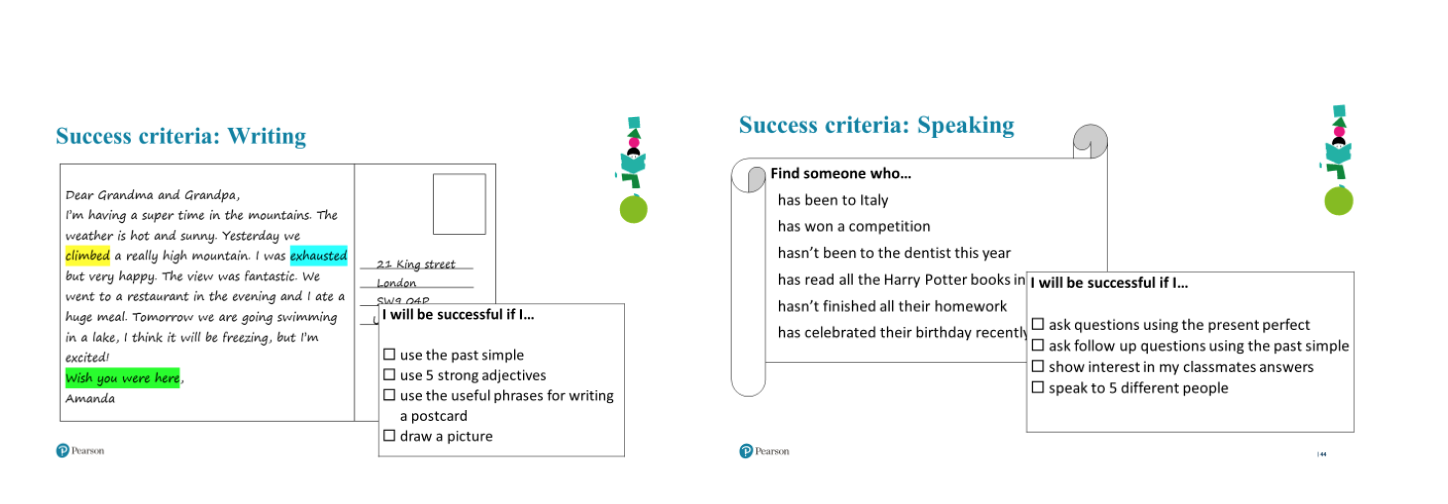The new school year is the ideal time for a fresh start. After all, once young students are in a routine they can be resistant to change, and it’s hard to find time to experiment once teaching is underway.
But too many changes all at the same time are difficult for teachers to manage and might be overwhelming for young students. And in most cases, major changes are not necessary.
In my experience, young learner teachers often want to focus on improving student engagement and motivation, and this is an area where Assessment for Learning (AfL) can be of great benefit.
I want to share some AfL strategies which encourage learners to take more responsibility for their own learning. These strategies won’t require huge changes to your teaching, but can be introduced and experimented with throughout the school year. A new beginning without all the pressure of making things perfect from the first day of term.
Learning objectives
Share learning objectives at the start of each lesson so students know what they are learning, how it will benefit them personally and what the expectations are for the lesson. Learning objectives should be specific, measurable and age appropriate, for example:
- I can write the instructions to a simple game.
- I can describe basic symptoms to a doctor.
Write the learning objective on the board then begin a discussion with your students, giving further questions if necessary. For the objective about symptoms you might ask:
- When did you last go to the doctor?
- What are some common reasons for going to the doctor?
- Can you say those things in English?
- What advice might the doctor give you?
Return to the learning objective at the end of each lesson so students can reflect on how successful they were. Once again, discussion questions are useful, for example; Which words in the lesson were new for you? Tell me three pieces of advice the doctor might give.
All of these discussions can take place in English or your students’ L1.
Success criteria
Success criteria ensure students know exactly what to do to succeed in a task. You can use them for any task, but they are particularly useful for speaking and writing when you want maximum effort and engagement from students. Set the task, and if possible show students a model. This could be a well-written text for writing, and a recording or a teacher demonstration for speaking.
Invite students to identify the key features of the model and help them to formulate these into success criteria. Students should write these in their notebooks to refer to throughout the task. Here are some examples:
After students complete a task, they should look back at the criteria and self or peer-assess how well they did. They can assess each point by drawing emojis, writing ticks, question marks and crosses or using red, orange and green coloring pencils to colour in boxes.
To get started with success criteria as well as the other strategies mentioned in this blog, watch our video summary series.
You can also read more in our article: Visible progress for primary learners.
Formative feedback
We give praise and feedback to students all the time, but feedback is only truly effective when it informs students not only what they did well or badly, but how they can improve. Here are some examples of helpful formative feedback:
Your article is very well balanced and interesting to read. To improve your work, include 4 linkers from the lesson (despite, although etc.) to organize your points.
I like the adjectives you used to describe your friend’s appearance (fashionable, slender). Can you tell me something about her personality? Is she patient, reliable?
To help you keep track of the feedback you are giving as well as other key AfL techniques, download our AfL Teacher Checklist.
Self- and peer reflection
To thrive in the 21st century our students need to learn how to work autonomously and independently, and self- and peer reflection is key. However, young students are not used to doing this, as traditionally that’s the teacher’s job. Therefore, extra support and scaffolding is essential.
Sentence stems and reflective questions are one way to help students focus on their own learning and can be used regularly before and after learning takes place. Use some of the ideas from my AfL classroom posters, or better still put one up in your classroom so students can refer to them whenever they need to.
Some other ways to facilitate reflection with young students include the use of Can Do Statements and learning diaries.
Can Do Statements can be used regularly at the end of a lesson, unit or cycle of work to encourage students to reflect on their progress and should be connected to the learning objectives for the lesson.
Learning diaries provide a safe place where students can communicate with their teacher about the things that matter to them. They can record their successes and challenges, as well as their language learning goals.
If you would like in depth training on how to implement Assessment for Learning with your students watch my webinar series. The five hour training program covers both theoretical and practical aspects with plenty of ideas for you to try out with your students.
—
If you enjoyed reading this – don’t forget to sign up for our mailing list below and receive the latest blog posts directly to your inbox!
The post How to improve student engagement with Assessment for Learning appeared first on Resources for English Language Learners and Teachers | Pearson English.
from Resources for English Language Learners and Teachers | Pearson English https://ift.tt/2MDPGi7
via Learn Online English Speaking
Comments
Post a Comment